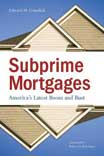About 1980, however, everything began to change. A second-tier mortgage market developed with a whole new jargon that has now become commonplace: subprime lending, predatory lending, ARMs, balloon payments, teaser rates, liar loans, piggyback loans, etc. As denial rates plunged, the challenge for CBOs shifted from redlining to predatory lending, from outright denial to exploitative pricing.
Gramlich traces the beginnings of the subprime industry to a 1980 federal law that repealed the usury, or interest-rate limits, on first-lien mortgages. New mortgage companies sprang up to meet the demand for higher-interest loans to riskier customers. State-regulated mortgage companies made about 50 percent of subprime loans with lightly regulated affiliates of federally regulated lenders making another 30 percent. The result, says Gramlich, was “a gigantic hole in the supervisory safety net.”
So what happened to free-market checks and balances? Isn’t competition supposed to drive down prices, maximizing utility for everyone? The problem, to use a fancy economists’ term, was “information asymmetry.” Sensing huge profits to be made at higher interest rates, subprime lenders invented a bewildering array of new loan products to entice customers, including loans that exceeded 100 percent of value and that had massive increases in monthly payments a few years in — so-called 3/27 or 2/28 loans or adjustable-rate mortgages. Complicated mortgage instruments often had poison pills buried in the legalese, like punishing prepayment penalties. While only 2 percent of conventional loans had prepayment penalties, 80 percent of subprime loans had them, thus making it much more difficult for borrowers to escape the subprime trap.
The proliferation of mortgage instruments made it very difficult, if not impossible, for consumers to make rational choices. Gramlich reports on one experiment showing that University of Chicago MBA students were not able to calculate the real cost of loans. When I took out my own mortgage, there was a pile of paper an inch and a half thick on my broker’s desk. Without benefit of a lawyer, my wife and I signed our names perhaps a dozen times. I could easily have been taken to the cleaners. Fortunately, my mortgage broker was honest. Millions of people were not so lucky.
Mortgage brokers played a key role in the rise of subprime lending. The number of independent mortgage broker firms soared from 7,000 in 1987 to 53,000 in 2004, and about 60 percent of all subprime mortgages were placed through brokers. Many people believe that mortgage brokers represent their interests. With little government oversight, however, mortgage brokers work on commissions and they often have incentives, called “yield spread premiums,” to steer borrowers into higher-cost loans. The destructive process was accelerated by technology. Electronic loan applications reduced application time to as little as 15 minutes, and borrowers were often not even required to submit proof of income.
According to market theory, even if customers were duped, predatory lending should have ground to a halt because no lender is going to continue giving out loans that won’t be paid back. By creating an innovative secondary market, however, the subprime industry severed the connection between those who originated the loans and those who funded them. Wall Street investment firms bought subprime mortgages and bundled them into “mortgage-backed securities” that they then sold to investors around the globe. By pooling thousands of subprime mortgages, they supposedly spread the risk of delinquency and foreclosure. Instead, these new, pooled securities were so complex they obscured the risk. The originators could dump the questionable loans on investors who had little idea what they were purchasing.
The subprime market was justified by what George Bush calls the “ownership society.” Homeownership clearly has benefits. Poverty is not just about the lack of income, but also about the lack of wealth. One of the benefits of homeownership is the ability to build equity that can serve as a safety net when unexpected shocks hit, like loss of a job or sudden medical expenses.
But the subprime market made families more vulnerable, not more resilient. Shockingly, over half of all first-time homebuyers leave homeownership within five years. Gramlich explained that as income variability increased in recent decades, the main cause of loan delinquency is loss of a job. Overburdened with debt, families facing a sudden loss of income are often forced into foreclosure, losing their assets and even their social networks.





Comments